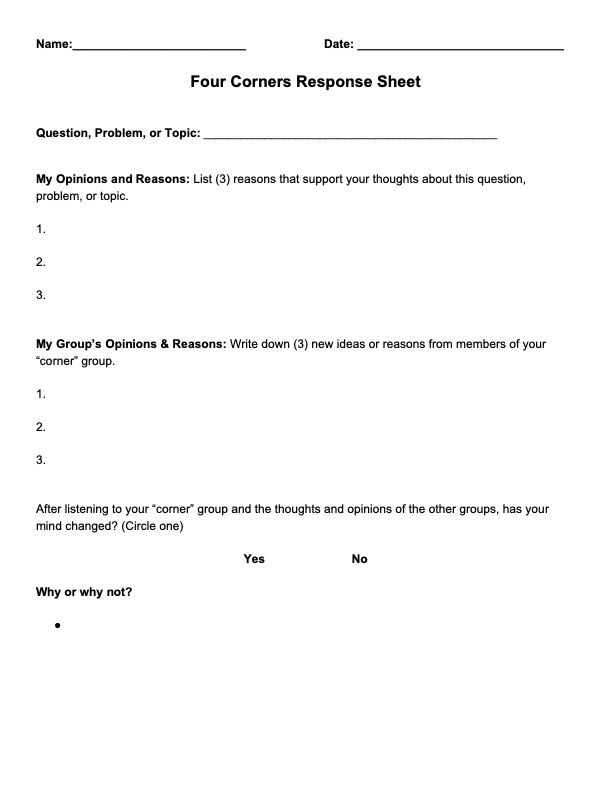Four Corners Teaching Strategy
Why: (Purpose)
- Cooperative Learning
- Promotes peer-to-peer discussion
- Encourages decision-making, self-management, and listening
- Deep Learning
- Collaborative learning
- Effective communication
- Developing academic mindsets and assessment skills
- Higher Student Achievement
- Promotes critical thinking and reasoning
- Allows students to align their learning
- Increases and reinforces communication skills
- Greater Engagement
- Movement while learning, leading to increased attentiveness
- Encourages students to rationalize and be decisive
- Provides students with the opportunity to be a leader
- Well-Being
- Gives students the opportunity for movement and choice
- Allows students to solidify and reassure themselves by seeing and hearing the responses of their peers
- Encourages more face-to-face communication with peers
What: (Description of the Strategy)
The Four Corners teaching strategy is designed to get students moving while assessing or introducing a topic or content. This strategy is one that asks students to make a decision about a question, problem, or topic by physically moving to a predetermined part of the room based on their response or choice. The four corners teaching strategy requires very little preparation, is easy to implement in just about any classroom or at any grade level, and allows for many variances driven by classroom need.
How: (How to Set Up the Strategy)
To use as a discussion starter:
- Create four different “opinion group” posters/labels and places one in each corner of the room (e.g., strongly agree, agree, disagree, strongly disagree).
- Generate a debatable statement related to the unit of study.
- Give students a minute to internalize the statement, construct their opinion, and move to the appropriate corner.
- Ask the students to record their reasoning and share it with a partner within the same “corner” group.
- Have students share within their group for 2-3 minutes before summarizing the group’s thinking and reasoning.
- Groups will take turns sharing their opinions and supporting their reasoning with the guidance of the teacher.
To use as a formative assessment:
- Assign each corner of the room a preference, topic, answer choice, etc.
- Pose the question or give the instructions, and the students move to their desired corner.
- Students then huddle in small groups (2-3) to discuss the preference, topic, answer choice, etc.
- Pose a follow-up question, piece of evidence, clarification, or task.
- Students then collaborate within their small groups to justify or support their responses.
- Student groups take turns sharing with the larger group. Check for understanding, clarify, and correct as needed.
Digital/Virtual Application of the Strategy:
For virtual implementation of this strategy, utilize one of the following variances:
- Ask students to hold up one, two, three, or four fingers to communicate their “corner” of choice.
- Ask students to hold their thumb up, down, left, or right to communicate their choice or opinion.
- Create and assign a different breakout room for each “corner” of choice before coming back together into a large group to share.
- Use Google Jamboard or a Google Doc and assign different pages for each “corner.” Ask students to post their reasoning or evidence on each.
The teacher may also choose to give students the opportunity to “prove” or “refute” the other choices or options as well, using the same setup.
Face-to-Face Application of the Strategy:
In a face-to-face setting, introduce the four corner teaching strategy by walking students through a dry run with a simple example (e.g., favorite type of food). Set and establish norms and expectations. Some basic ones include:
- Where students begin the activity (at their seats, in the middle of the room, etc.)
- How the students are allowed to move (walk, hop, creep, etc.)
- How long students have to choose their corner
- What the teacher will use to manage time (voice, timer, etc.)
- What discussion questions the students will use at their corner
- Who will speak for the group and how (e.g., thinking and response stems)
Then pose a question, problem, or identify a topic for the students to think about before asking them to move to their selected “corner” to prepare for discussion. In an ideal setting, this will consist of students distributed throughout the four corners of the classroom with the teacher facilitating from a central location.
Students will communicate with one another for a specified amount of time before selecting a spokesperson to summarize their “corner” evidence and reason with the rest of the class. After hearing from all corners, allow any students to “change their mind” based on evidence provided. After a question, problem, and/or topic is covered, the students will return to the designated starting area to prepare for the next activity.
Graphic Organizer:

